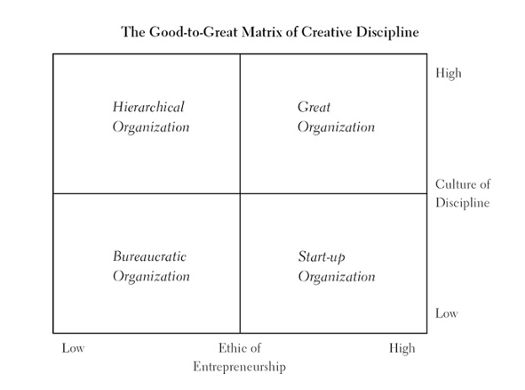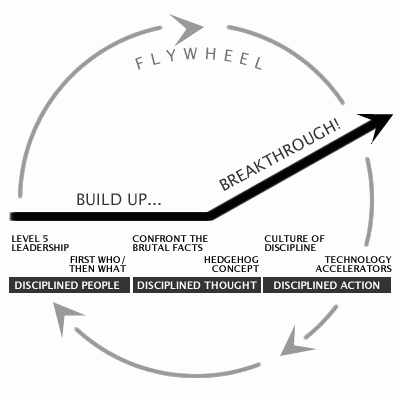
Entrepreneurial success is fueled by creativity, imagination, bold moves into uncharted waters, and visionary zeal. As a company grows and becomes more complex, it begins to trip over its own success - too many people, too many new customers, too many new orders, too many new products. What was once great fun becomes an unwieldy ball of disorganized stuff. Lack of planning, lack of accounting, lack of systems, and lack of hiring constraints create friction.
Matrix of creative discipline
In response, the company begins to hire MBAs and seasoned executives from blue-chip companies. Processes, procedures, checklists, and all the rest begin to sprout up like weeds. What was once an egalitarian environment gets replaced with a hierarchy. Chains of command appear for the first time. Reporting relationships become clear, and an executive class with special perks begins to appear.
Most companies build their bureaucratic rules to manage the small percentage of wrong people on the bus, which in turn drives away the right people on the bus, which then increases the percentage of wrong people on the bus, which increases the need for more bureaucracy to compensate for incompetence and lack of discipline. Avoid bureaucracy and hierarchy and instead create a culture of discipline. When you put these two complementary forces together - a culture of discipline with an ethic of entrepreneurship - you get the magical alchemy of superior performance and sustained results.

The one central idea is: Build a culture full of people who take disciplined action within the three circles, fanatically consistent with the Hedgehog Concept.
- Build a culture around the idea of freedom and responsibility, within a framework.
- Fill that culture with self-disciplined people who are willing to go to extreme lengths to fulfill their responsibilities.
- Don't confuse a culture of discipline with a tyrannical disciplinarian.
- Adhere with great consistency to the Hedgehog Concept, exercising an almost religious focus on the intersection of the three circles.
Freedom and responsibility within a framework
The good-to-great companies built a consistent system with clear constraints, but they also gave people freedom and responsibility within the framework of that system. They hired self-disciplined people who didn't need to be managed, and then managed the system, not the people.
In a sense, much of this book is about creating a culture of discipline. It all starts with disciplined people. The transition begins not by trying to discipline the wrong people into the right behaviors, but by getting self-disciplined people on the bus in the first place. Next, we have disciplined thought. You need the discipline to confront the brutal facts of reality while retraining resolute faith that you can and will create a path to greatness. Most importantly, you need the discipline to persist in the search for understanding until you get your Hedgehog Concept. Finally, we have disciplined action, the primary subject of this chapter. This order is important. The comparison companies often tried to jump to disciplined action. But disciplined action without self-disciplined people is impossible to sustain, and disciplined action without disciplined thought is a recipe for disaster.

Throughout the research, the authors were struck by the continual use of words like disciplined, rigorous, dogged, determined, diligent, precise, fastidious, systematic, methodical, workmanlike, demanding, consistent, focused, accountable, and responsible. People in the good-to-great companies became somewhat extreme in the fulfillment of their responsibilities, bordering in some cases on fanaticism.
A culture, not a tyrant
Whereas the good-to-great companies had Level 5 leaders who built an enduring culture of discipline, the unsustained comparisons had Level 4 leaders who personally disciplined the organization through sheer force. A spectacular rise under a tyrannical disciplinarian, followed by an equally spectacular decline when the disciplinarian stepped away, leaving behind no enduring culture of discipline, or when the disciplinarian himself became undisciplined and strayed wantonly outside the three circles. Discipline is essential for great results, but disciplined action without a disciplined understanding of the three circles cannot produce sustained great results.
Fanatical adherence to the hedgehog concept
The good-to-great companies at their best followed a simple mantra: "Anything that does not fit with our Hedgehog Concept, we will not do. We will not launch unrelated businesses. We will not make unrelated acquisitions. We will not do unrelated joint ventures. If it doesn't fit, we don't do it. Period."
Few companies have the discipline to discover their Hedgehog Concept, much less the discipline to build consistently within it. They fail to grasp a simple paradox: The more an organization has the discipline to stay within its three circles, the more it will have attractive opportunities for growth. Indeed, a great company is much more likely to die of indigestion from too much opportunity than starvation from too little. The challenge becomes not opportunity creation, but opportunity selection. It takes discipline to say "No, thank you" to big opportunities. The fact that something is a "once-in-a-lifetime opportunity" is irrelevant if it doesn't fit within the three circles.
Start a "stop doing" list
We have ever-expanding "to do" lists, trying to build momentum by doing, doing, and doing more. It rarely works. Those who built the good-to-great companies, however, made as much use of "stop doing" lists as "to do" lists. They displayed a remarkable discipline to unplug all sorts of extraneous junk.